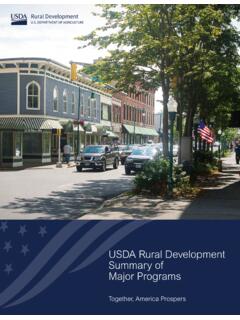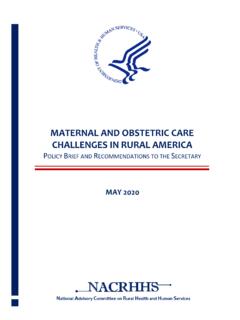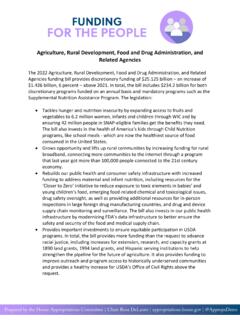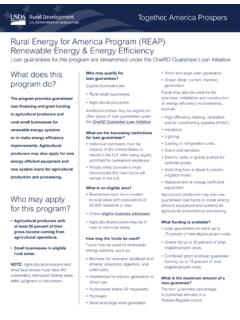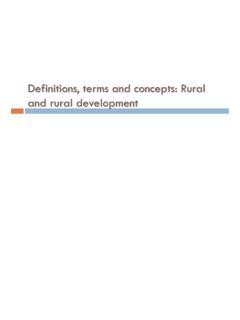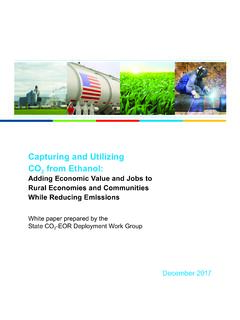Transcription of Improving Access to Maternal Health Care In Rural ...
1 Improving Access to Maternal Health care in Rural Communities ISSUE BRIEF Improving Access to Maternal Health care in Rural Communities | Issue Brief i CONTENTS Executive Summary .. 1 Introduction .. 3 Access to Maternal Health care in Rural Communities .. 6 Before Pregnancy .. 7 During Pregnancy .. 8 After Pregnancy .. 11 Opportunities to Improve Access to Maternal Health care in Rural 12 Accessible: Delivers care via a Multidisciplinary Workforce .. 12 Affordable: Reduces Financial Barriers for Mothers and 15 Risk-Appropriate: Exemplifies a High-Functioning Maternal Health System .. 17 High Quality: Provides Safe, Timely, Efficient, and Effective care and services .. 18 Patient-Centered: Values the Whole Person and Family .. 19 Innovative: Leverages Telehealth and Related 20 Coordinated: Connects Women to Behavioral and Social Supports.
2 21 Equitable: Provides High-Quality, Patient-Centered care to All Women .. 22 Highlighted Examples: Improving Access to Maternal Health care in Rural Communities .. 25 Conclusion .. 29 Appendix A. Distribution of Hospital Obstetric Unit Closures in Micropolitan and Noncore Counties, 2004 2014 .. 30 Appendix B. Scope of Practice Among Maternal Health Providers .. 31 Appendix C. Summary of Six Case Studies .. 33 Appendix D. Acronyms List .. 48 Endnotes .. 49 Improving Access to Maternal Health care in Rural Communities | Issue Brief 1 EXECUTIVE SUMMARY Across the country and at every level of government there has been a growing focus on Rural Health . At the same time, rising Maternal mortality rates and the disproportionate affect they have on Black, American Indian, and Alaska Native women is of great concern. Rural Maternal Health care is therefore an administration priority and the Centers for medicare & medicaid services (CMS) has been focused on Improving Rural Maternal Health outcomes.
3 Specifically, CMS has aligned Health policies to its Rural Health Strategy and its new Rethinking Rural Health Initiative, released its first medicaid and Children s Health Insurance Program (CHIP) Scorecard to evaluate state progress on Maternal Health outcomes, and is preparing to implement the recently enacted Improving Access to Maternity care Act and Preventing Maternal Deaths Act. This issue brief was developed by CMS to provide background information on the scope of this problem and to focus attention on the need for national, state, and community-based organizations to collaborate on developing an action plan to improve Access to Maternal Health care and improve outcomes for Rural women and their babies. A lack of Access to high quality Maternal Health services in Rural communities is the result of many factors including hospital and obstetric department closures, workforce shortages, and Access to care challenges arising from the social determinants of Health which have contributed to disparities in Maternal Health care for Rural women and their babies.
4 These Access challenges can result in a number of negative Maternal Health outcomes including premature birth, low-birth weight, Maternal mortality, severe Maternal morbidity, and increased risk of postpartum depression. These Health disparities affect American Indian and Alaska Native and women of color disproportionately. Since one in five Americans live in a Rural community, including approximately 18 million women of reproductive age, it is critical that federal, regional, state, local agencies and communities work together to improve Access to high quality Maternal Health services in Rural communities. Hospital closures: Since January 2010, more than 100 Rural hospitals have closed, with a disproportionate share occurring in the South. Multiple factors contributed to these closures. Among them were higher rates of uninsured patients, large amounts of uncompensated care , financial distress, hospital size, and community poverty rates.
5 Between 2004 and 2014, 179 Rural counties lost or closed their hospital obstetric services . Consequentially, fewer than 50% of Rural women have Access to perinatal services within a 30-mile drive from their home and more than 10% of Rural women drive 100 miles or more for these services . These conditions affect Access to care before, during, and after pregnancy and are more pronounced in the Black and Hispanic communities, and disproportionately affects low-income women. Access to care : Before pregnancy the Health and wellness of a woman is critical to achieving safe outcomes for her and her baby. Access to care is vital during this period because it allows providers to identify, treat, and stabilize chronic conditions; address behavioral Health needs; and, plan for a healthy and intentional pregnancy. During pregnancy a woman s need for Access to Maternal Health services increases.
6 Prenatal care can reduce the risk of pregnancy complications for both the mother and child. After pregnancy women must establish or reestablish their well-woman care . At each point along this continuum women in Rural communities experience challenges and barriers. Insurance coverage: medicaid is the nation s single largest payor of perinatal care and is especially important in Rural areas. In 2017, medicaid paid for 43% of all births in the United States ( of the million births) and an estimated 50-60% of births in Rural ,2 However, many women covered by medicaid lose their coverage 60 days postpartum. This loss of Health coverage increases the likelihood that these women will receive inadequate or no Health services , increases their risk of morbidity and Improving Access to Maternal Health care in Rural Communities | Issue Brief 2 mortality, and increases their likelihood of receiving no support for conditions that emerge after the 60- day period.
7 However, the loss of medicaid eligibility is a qualifying event to enroll in Exchange coverage, and the president's 2020 budget proposes giving states the authority to allow mothers with substance abuse disorder to stay eligible for medicaid for one year after giving birth. Workforce supply and distribution: Maternal Health care is delivered by a vast array of providers specialty providers; primary care providers, including advanced practice nurses; nurses; community Health workers; and doulas. Each of these Health care professionals plays a critical role in providing Maternal Health care before, during, and after pregnancy. However, there is a shortage of Maternal Health care providers in Rural and urban areas. By 2020, it is estimated that the US will have a shortage of 6,000-8,800 obstetricians and gynecologists (OB-GYNs) with a projected increase in that shortage to 22,000 by 2050.
8 The shortage is more severe in Rural areas, where many counties do not have a practicing OB-GYN. Although family physicians are the largest group of Rural obstetrical providers, midwives are another important source of Maternal Health services in Rural While midwives currently attend less than 10% of all births in the US, they attend over 30% of deliveries in Rural hospitals. There are still barriers to the practice of midwifery across the country even though midwifery has proven to be a safe and cost-effective mode of Maternal Health , 5, 6 Although some states have limits on the services covered, all states provide coverage of certified nurse midwife services through medicaid . In contrast, many private insurance plans do not cover services provided by midwives or offer only limited coverage. Other providers that deliver critical services to women before, during, and after pregnancy, including behavioral Health providers and dentists, are also difficult to Access in Rural communities.
9 The lack of adequate, high quality Maternal Health care in Rural communities has led many Rural communities to find creative and innovative solutions to address some of the Maternal Health care delivery challenges in their communities. These innovative solutions include opportunities to improve Access to a skilled Maternal Health workforce by expanding training of Maternal Health providers in Rural areas, incentivizing Maternal Health providers to practice in Rural areas, leveraging the existing Health care workforce, and standardizing scope of practice laws for Maternal Health providers. Some programs are working to make Maternal Health care more affordable by paying for the cadre of Maternal Health providers, expanding and extending insurance coverage, unbundling postpartum services , and establishing accountable care organizations covering Maternal Health services .
10 Others have implemented programs to increase Access to risk-appropriate, quality care ; to establish frameworks for high-quality care ; and, to address patient -centered care and care coordination. By working together to ensure widespread dissemination and adoption of these programs, we will move closer to ending the gap in Maternal Health disparities and ensure that all Rural women and their babies have better Maternal Health outcomes. Improving Access to Maternal Health care in Rural Communities | Issue Brief 3 INTRODUCTION In an ideal Maternal Health system, all women would have Access to comprehensive, seamless medical care with links to behavioral, economic, and social supports. Additionally, they would be engaged with this system before, during, and after pregnancy. Across the United States, many women are not receiving care in this ideal system, and women in Rural communities face unique challenges that make it harder for them to reach this ideal or any care at all in some cases.










